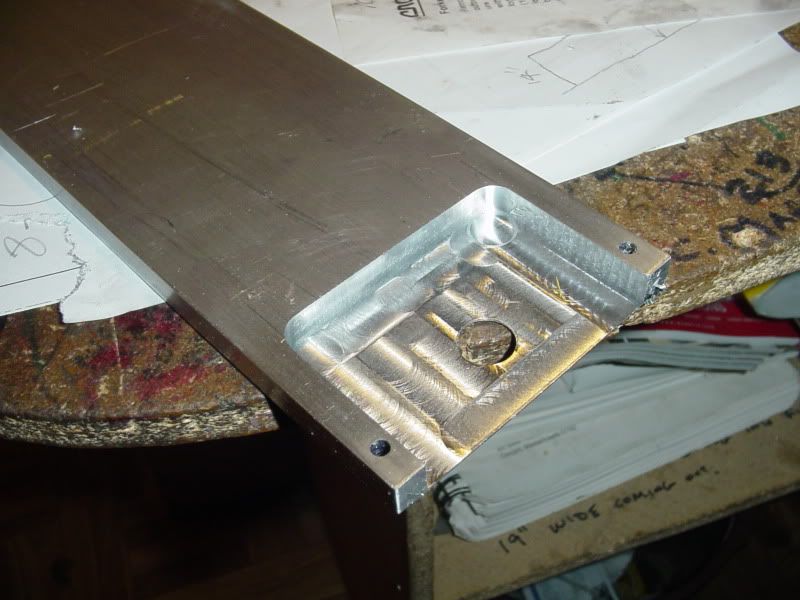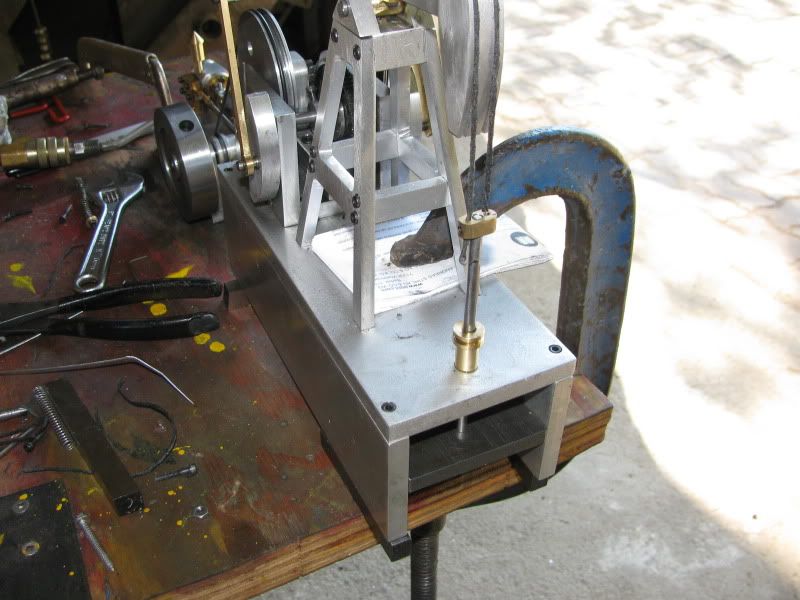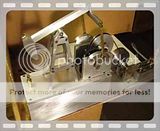Thanks Bearcar---There is a bicycle shop on the way to my nut and bolt store where I buy my set screws---I'll pay them a visit tomorrow.
You are using an out of date browser. It may not display this or other websites correctly.
You should upgrade or use an alternative browser.
You should upgrade or use an alternative browser.
Building the Pumpjack
- Thread starter Brian Rupnow
- Start date

Help Support Home Model Engine Machinist Forum:
This site may earn a commission from merchant affiliate
links, including eBay, Amazon, and others.
putputman
Senior Member
- Joined
- Nov 22, 2008
- Messages
- 600
- Reaction score
- 55
Brian, how about that braided fish line that was used before monofilement line showed up. Some of us in the North (not quite as far North as you) still use it. It is strong, limber, and black, and you probably won't run that pump until the oil shows up so it is strong enough.
By the way, I have followed this post from the beginning and have enjoyed it. You should have a lot of fun with the pump. Been waiting for you to finish before I start mine.
It seems that everytime you show someone an engine, they say "what does it do". Now you can show them. You are preparing for retirement by pumping oil.
By the way, I have followed this post from the beginning and have enjoyed it. You should have a lot of fun with the pump. Been waiting for you to finish before I start mine.
It seems that everytime you show someone an engine, they say "what does it do". Now you can show them. You are preparing for retirement by pumping oil.
I went by the bicycle shop this morning and picked up some beautifull stainless stranded cable.--But---Although it works, it simply has too much "memory". If I want it to hang properly (as in straight down from where it is supported by the "Horsehead" then I have to increase the spring which pulls the pumprod down---to a point where the drive belt slips or the steam engine simply runs out of power and everything stalls. My next effort will be to try and find some nice black "string" to act as my wire rope. It will be very flexible, with no "memory" like the steel cable has, so will look a lot more "realistic" when the pump is operating. I need something just slightly less than 1/16", which is the width of the slots in the Horsehead.
That is too bad about the cable Brian. I didn't think about the method that it is packaged in the stores. (coiled up in about a 4" coil) It does have a tendency to take a 'set' after a period of time. Most of that type of cable can be soldered with soft solder, perhaps you could extend a piece out straight and 'gently' wick some solder into the strands enough to make it stiff enough not to want to re-coil. Also I wonder if hanging a weight from the ceiling by a long piece before it is cut off and the application of some mild heat would allow the strands to relax enough to get it to straighten out. Otherwise, as PutPutman suggested, very heavy fishing line or leader should work.
BC1
Jim
BC1
Jim
Bearcar---No, thats not what I meant. If you look closely at the way these pumpjacks work, the cable is constantly flexing as the horsehead goes up and down. It is always coming off tangent to the circumferance of the horsehead. On a full sized rig, there is enough weight in the pumprod to always keep the cables pulled tight against the face of the horsehead. On a little model like mine, even with an extremely flexible cable, you can't put enough "weight" on the cables to make it lay flat against the horsehead without stalling the engine.--So you end up with a "hump" in the cable where it comes off the horsehead which just doesn't look right. I found some heavy string and died it black with liquid shoepolish---its outside right now drying in the sun. Later today, I'll try it with that.---Brian
This is proving to be more difficult than I thought it would!!! The string blackened with shoe polish works fine---bends the way its supposed to and doesn't hump up---but---I am not having a lot of luck with the spring which pulls the pump-rod down, to keep tension on the string. The trouble with compression springs is that they have a limited range of movement from "locked up solid--fully compressed with no space left between the coils" to "fully expanded to greatest length". and--they are not consistent in the force they apply--a spring just about at full expansion has very little "power", whereas a spring at "nearly full compression" has quite a lot of power.--This inconsistency of pull on the strings is giving me grief. It runs perfect if I apply a constant "push" on top of the pumprod while its running.--This sparked plan B---Remove the spring and put a weight on the end of the pump-rod, thus giving a consistent downforce. Another problem is that the rod wants to rotate as it goes up and down, and the strings offer no resistance to that, so after running for 3 or 4 minutes my nice "wire rope" harness looks more like a twist-tie!!!! Now Plan B has a few "Gotchas".---The biggest one being that my "Horsehead" travels 2.5" vertically---and the risers under the pumpjack base are 2 1/2" bars. Thus---the nice pocket that you see here milled 0.350 deep in the main base palte. My old brain is sizzling tonight---If I make the "weight" 1/16" narrower than the space between the "riser bars", than it should also prevent the pumprod from rotating. (It will be attached to the end of the pump-rod" with a counterbored #5 socket head cap screw.) The weight itself will be a steel or brass bar, 1 3/8" x 5/16" thick x 2 11/16" long with the counterbored hole in the center. This while I am trying to work two design contracts at the same time. Arghhh!!!


- Joined
- Jan 19, 2010
- Messages
- 1,193
- Reaction score
- 41
NIce work around Brian. Very good idea. If it were me, (and it aint) I would go with the steel bar, brass is kinda spendy to be hiding in the base, and not much heavier.
Kel
Kel
Found out a couple of things today. Firstly, the string idea works well, but I will need to find a better quality string than my butchers cord.---Perhaps good quality black fishing line. Secondly, the weight as opposed to a spring on the pump-rod really does work great, with the added benefit that it keeps the pump-rod from rotating---You can see it (just barely) on the bottom of the pump-rod in the picture.--And thirdly---the riser bars are going to have to be increased from 2 1/2" high to 3" high to give enough room for the weight to travel thru its full up to full down position and not catch or bind on anything. Biggest problem right now is I simply don't have any time to work on it.


Brian,
Have you considered the use of high strand copper cable in place of the steel/string?
Quality Multimeter test leads are typically a high strand count, high flex cable, especially those manufactured with silicon rather than PVC sheaths. Some of this can have over 600 strands in a cable only 2.4mm diameter, such as http://au.farnell.com/mc-multi-contact/61-7610-25/wire-silicon-green-2-50mm-5m/dp/4326994
With the sheath stripped off, and the copper painted, it would give the appearance of a multi-strand steel cable and I doubt it would have the memory/rigidity of steel.
The only issue may be the work hardening of the copper over time, but I have seen my fair share of multimeter leads that have been used and abused by electricians for many years without failure.
Perhaps your local electronics supplier may have an inexpensive test lead kit or hopefully sell it by the metre/foot.
Tony.
Have you considered the use of high strand copper cable in place of the steel/string?
Quality Multimeter test leads are typically a high strand count, high flex cable, especially those manufactured with silicon rather than PVC sheaths. Some of this can have over 600 strands in a cable only 2.4mm diameter, such as http://au.farnell.com/mc-multi-contact/61-7610-25/wire-silicon-green-2-50mm-5m/dp/4326994
With the sheath stripped off, and the copper painted, it would give the appearance of a multi-strand steel cable and I doubt it would have the memory/rigidity of steel.
The only issue may be the work hardening of the copper over time, but I have seen my fair share of multimeter leads that have been used and abused by electricians for many years without failure.
Perhaps your local electronics supplier may have an inexpensive test lead kit or hopefully sell it by the metre/foot.
Tony.
I haven't abandoned the project---I've just been extremely busy with my "Real Job". I've got the pumpjack running just beautifull!!! I had to change the riser bars between the main baseplate and the baseplate on the pumpjack from 2 1/2" to 3" in order to get room for full travel of my suspended weight, and after searching all over for some good, flexible cord to be my wire rope harness, I stopped today at a shoe repair shop, and they gave me a couple of foot of their strongest black sewing thread used for shoe repair. It looks good, and runs very smoothly. I will be posting a newer (and I hope better) video within the next 24 hours.----Brian
And here we have the final act----A good video. I had to phone my daughter and have her bring her camera over, as my own camera is not focusing well for some reason. Thank you to all the folks who dropped in to see how things were going on this long project, and I urge you to download the plans I provided and build one. It is not a terribly complex build, and it certainly is a good match for Elmer Verburg size engines.----Brian


tel
Well-Known Member
- Joined
- Feb 8, 2008
- Messages
- 3,293
- Reaction score
- 44
and I urge you to download the plans I provided and build one.
OK Brian, still held up on resuming the oscillator so I'm taking you at your word.
A start made on the horsehead (as that seemed the trickiest bit) and the beam. For some reason I got it stuck in my head that I wanted the beam to be an 'I' beam, so that has introduced a few complications, however, they seem to be sorting themselves out. Had to mill the 'I' beam from a bit of brass, then devise a way of holdin beam and horsehead together.


Good on you Tel---You are the first of what I hope will be many to build this one.---Brian
Similar threads
- Replies
- 356
- Views
- 54K



